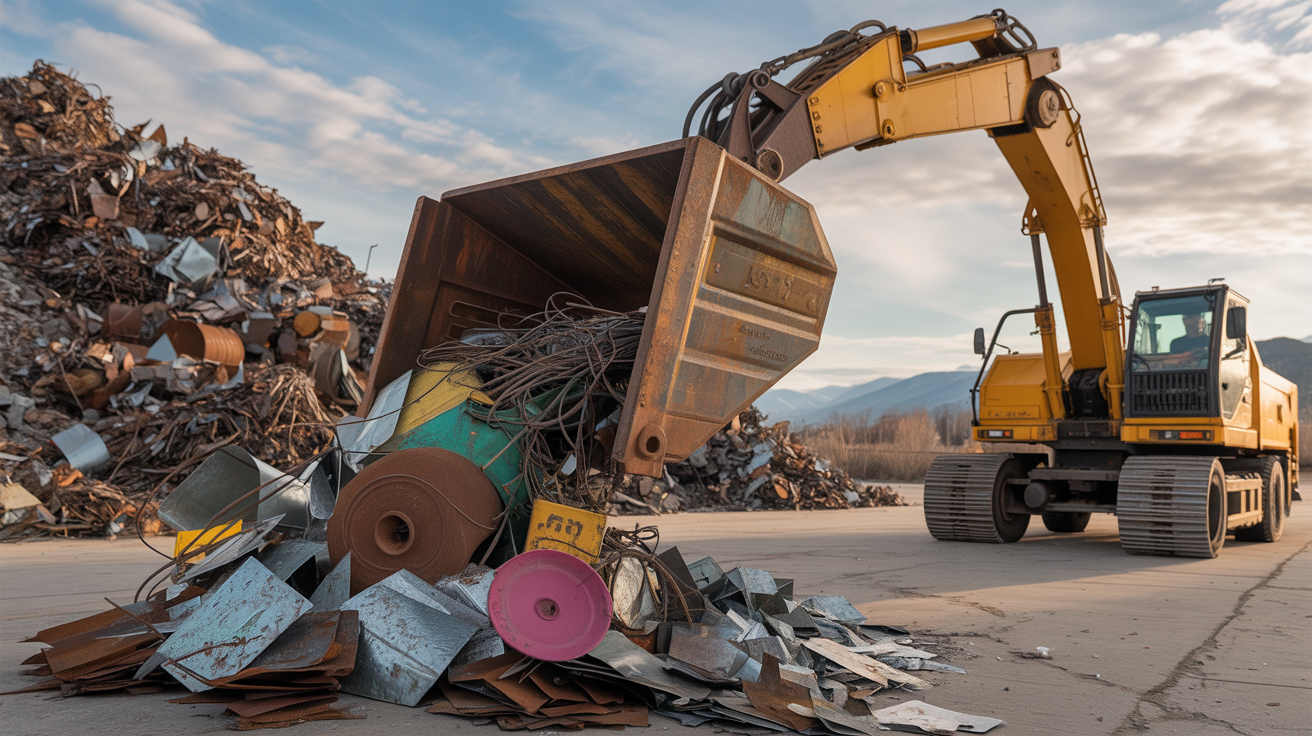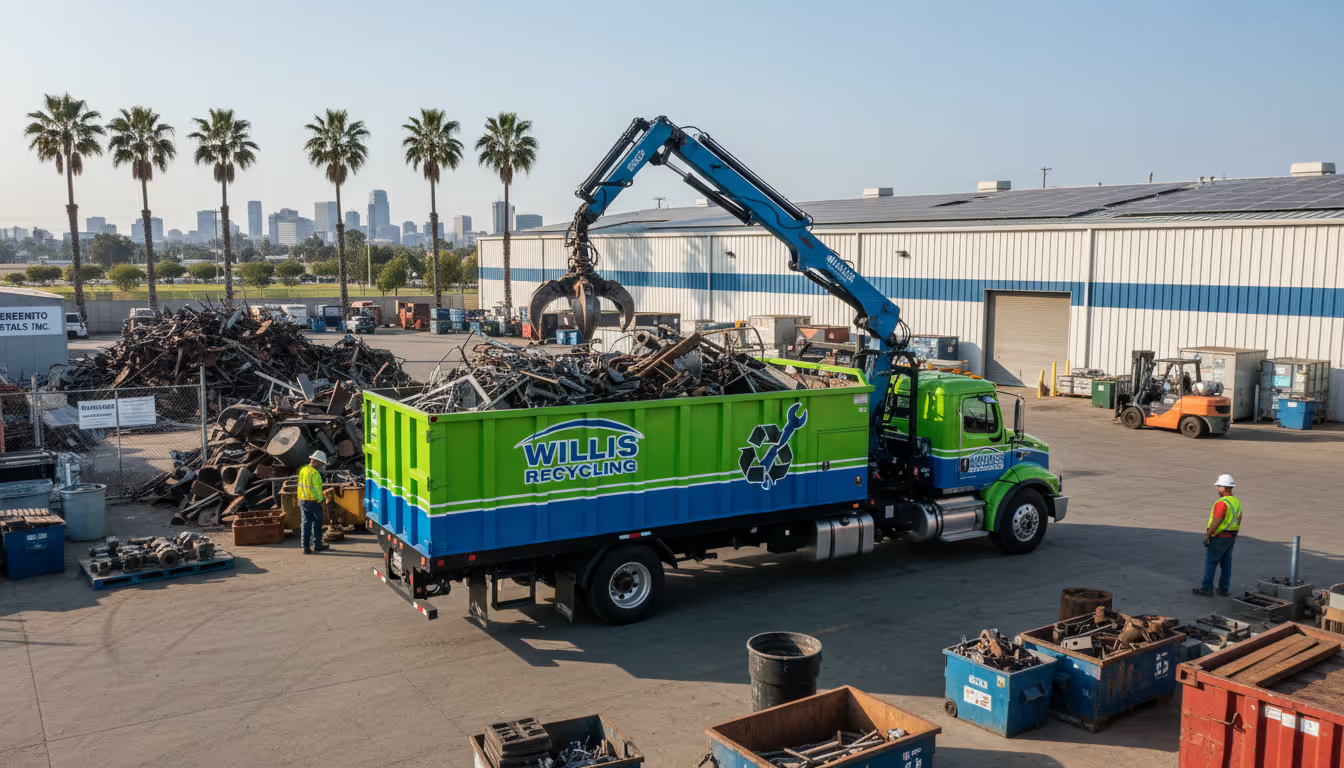A Business Owner's Guide to Safety and Savings
Effective scrap metal safety requires cut-resistant gloves rated ANSI/ISEA 105 Level 3 or higher, safety glasses with side shields, steel-toed boots meeting ASTM F2413 standards, and proper material organization in designated containers elevated off the floor. These measures prevent costly injuries that average $43,000 per incident while helping businesses avoid OSHA fines ranging from $16,550 to $165,514 per violation.
Introduction: When Safety Meets the Bottom Line
Last month, a Sacramento auto repair shop owner watched his workers' compensation rates triple after a single scrap-related injury. The employee needed twelve stitches from a sheet metal cut—an accident that could have been prevented with $30 gloves.
This scenario plays out across California businesses daily. Whether you're running a tire center in Fresno or managing construction sites throughout the Central Valley, improper scrap metal handling threatens both your workforce and your financial stability.
The numbers tell a sobering story. The National Safety Council reports that workplace injuries now cost employers an average of $43,000 per incident when accounting for medical expenses, lost productivity, administrative time, and replacement training. For businesses handling scrap metal regularly, the risks multiply with every unsecured pile and unprotected worker.
Understanding Your Exposure: Hidden Costs Beyond Medical Bills
Think about your current scrap handling process. How many times have workers grabbed metal pieces barehanded? How often do they step around piles on the shop floor? Each unsafe practice compounds your financial exposure.
The Cascade of Costs
When injuries occur, the immediate medical expenses represent just 20% of the total financial impact. Consider what happened at a Bay Area manufacturing facility:
The Initial Incident: A worker strained his back lifting a 60-pound copper coil incorrectly. The direct medical cost: $8,500.
The Ripple Effect:
Lost productivity during recovery: $12,000
Overtime for coverage: $4,800
Administrative burden: $3,200
Training temporary replacement: $2,100
Increased insurance premiums (3-year impact): $18,000
Total cost: $48,600
Back injuries alone represent approximately 20% of all workplace injury cases, with manual material handling being a primary contributor. These injuries often result in extended recovery periods, averaging 12 days away from work compared to 8 days for other injury types.
Regulatory Financial Penalties
OSHA's 2025 penalty structure reflects increased enforcement priorities:
Serious violations: $16,550 per violation
Willful violations: Up to $165,514 per violation
Repeated violations: $165,514 per violation
Failure to abate: $16,550 per day beyond the abatement date
A single workplace inspection uncovering multiple safety violations can easily result in six-figure fines. One California recycling facility received $87,000 in penalties for inadequate PPE provisions, improper material storage, and missing safety training documentation.
Critical Hazards in Scrap Metal Operations
Laceration and Puncture Risks
Sharp edges remain the most frequent source of injuries. Modern manufacturing processes create increasingly complex metal shapes with multiple cutting surfaces. Workers face exposure to:
Burrs and rough edges from plasma cutting or grinding operations
Spring-loaded tension in coiled materials that can suddenly release
Hidden sharp points within stacked materials
Contaminated surfaces carrying oils, chemicals, or biological hazards
Emergency room data shows that hand lacerations from metal handling average 2.5 inches in length and frequently damage tendons or nerves, leading to permanent disability in 15% of cases.
Ergonomic and Musculoskeletal Threats
The irregular shapes and unpredictable weight distribution of scrap metal create unique lifting challenges. Research indicates that asymmetric lifting—common with scrap materials—increases spinal compression forces by 30% compared to balanced loads.
Workers frequently underestimate weights, especially with materials like lead (708 pounds per cubic foot) or copper (559 pounds per cubic foot). This miscalculation leads to sudden overexertion injuries that can cause permanent disability.
Environmental and Chemical Hazards
Scrap metal often carries residual substances that pose additional risks:
Cutting fluids and lubricants causing slip hazards
Lead-based paints on older materials requiring special handling
Asbestos insulation on vintage equipment components
Mercury switches in automotive scrap
Implementing Cost-Effective Safety Solutions
Personal Protective Equipment: Your First Investment
The right PPE dramatically reduces injury rates while maintaining productivity. Here's what current safety standards require:
Hand Protection:
ANSI/ISEA 105-2016 Level A3 or higher cut-resistant gloves
Puncture resistance rating of Level 2 minimum
Grip coating for wet conditions
Cost: $25-40 per pair, lasting 2-3 months with proper care
Foot Protection:
ASTM F2413-18 compliant safety footwear
Impact resistance (I/75 or C/75 rating)
Compression resistance (C/75 rating)
Puncture resistance (PR rating)
Cost: $120-180 per pair, typically lasting 6-12 months
Eye and Face Protection:
ANSI Z87.1 rated safety glasses with side shields
Face shields for cutting or grinding operations
Cost: $15-30 for glasses, $25-40 for face shields
Studies show that proper PPE usage reduces injury rates by 60% when combined with appropriate training. The return on investment typically occurs within three months through reduced injury costs alone.
Workspace Organization: Engineering Out Hazards
Strategic workspace design eliminates many risks before they can cause injuries:
Vertical Storage Systems: Installing wall-mounted racks or vertical storage bins removes materials from floor level, reducing trip hazards by 75%. Implementation costs of $2,000-5,000 pay for themselves through improved efficiency and reduced injuries within six months.
Designated Processing Zones: Creating specific areas for different metal types with clear boundaries prevents cross-contamination and improves workflow. Mark these zones with industrial floor tape and maintain 28-inch minimum clearance for emergency egress routes as required by OSHA standards.
Material Handling Equipment: Investing in proper equipment eliminates manual lifting for heavy items:
Magnetic lifters for ferrous metals ($500-2,000)
Pallet jacks with metal bins ($800-1,500)
Overhead hoists for repetitive lifting ($2,000-8,000)
Training Programs That Deliver Results
Effective training reduces incidents by 30-60% according to peer-reviewed safety research. Focus your program on these critical elements:
Hazard Recognition Training (4 hours initially, 1 hour quarterly): Teach workers to identify sharp edges, unstable piles, and contaminated materials. Use actual examples from your facility to make training relevant. Document all sessions with attendance sheets and comprehension tests.
Proper Lifting Mechanics (2 hours initially, 30 minutes monthly): Demonstrate the biomechanics of safe lifting with hands-on practice. Include team lifting protocols for items over 50 pounds. Regular reinforcement prevents workers from reverting to unsafe habits.
Emergency Response Procedures (2 hours annually): Cover first aid for lacerations, proper cleanup of blood spills, and emergency contact protocols. Ensure multiple employees per shift have basic first aid certification.
The Business Case for Professional Scrap Management
Many California businesses discover that outsourcing scrap handling to professionals like Willis Recycling actually reduces costs while eliminating safety risks. Here's the financial analysis:
Traditional In-House Handling Costs
Labor allocation: If three employees spend 8 hours weekly on scrap management at $28/hour (including benefits), annual cost: $43,680
Equipment and supplies: Storage containers, PPE, handling equipment, maintenance: $8,000 annually
Insurance impact: Higher premiums due to exposure, typically 15-20% increase on workers' compensation
Opportunity cost: 1,248 annual labor hours diverted from revenue-generating activities
Total annual cost: $65,000-75,000 for a medium-sized operation
Professional Service Advantages
Mobile recycling services eliminate these costs while providing:
Trained crews with comprehensive insurance coverage
Specialized equipment for safe, efficient removal
Regulatory compliance and proper documentation
Potential revenue from scrap value
Freed space for productive use (200 sq ft = $7,200 annual value in Sacramento commercial rates)
The typical break-even point occurs at 500 pounds of scrap monthly, with larger volumes generating positive cash flow through material sales revenue.
Action Plan: Implementing Safety Improvements Today
Week 1: Assessment and Immediate Corrections
Conduct a photographic audit of current practices
Identify and eliminate immediate hazards (materials on floors, missing PPE)
Order necessary safety equipment with expedited shipping
Post temporary warning signs in high-risk areas
Week 2: Infrastructure Improvements
Install proper storage systems (prioritize highest-risk materials)
Establish designated scrap zones with clear markings
Implement material segregation protocols
Create written standard operating procedures
Week 3: Training and Documentation
Conduct comprehensive safety training for all affected employees
Demonstrate proper PPE usage and maintenance
Practice emergency response scenarios
Establish documentation systems for compliance
Week 4: Systems and Partnerships
Evaluate professional recycling service options
Implement inspection checklists and audit schedules
Review and update insurance coverage
Establish metrics for tracking safety performance
Measuring Success: Key Performance Indicators
Track these metrics to validate your safety investment:
Leading Indicators:
PPE compliance rate (target: 100%)
Safety training completion (target: 100% within 30 days of hire)
Near-miss reports (increasing reports indicate better awareness)
Safety audit scores (target: 90% or higher)
Lagging Indicators:
Days without injuries (celebrate milestones)
Workers' compensation claims (target: 50% reduction year-over-year)
OSHA recordable rate (target: below industry average of 3.0)
Insurance premium modifications (target: below 1.0 modifier)
The Path Forward: Safety as Competitive Advantage
Progressive California businesses recognize that superior safety performance creates competitive advantages beyond cost reduction. Companies with strong safety records attract better employees, win more contracts (especially government contracts requiring safety qualifications), and build stronger community reputations.
The return on safety investments consistently ranges from $4 to $6 per dollar spent, according to comprehensive studies by the National Safety Council and OSHA. This ROI comes through:
Reduced injury costs and insurance premiums
Improved productivity from fewer disruptions
Enhanced employee morale and retention
Avoided regulatory penalties and legal costs
Increased business opportunities from safety credentials
Conclusion: Taking Action Before Accidents Occur
Every day without proper scrap metal safety measures increases your financial exposure. The question isn't whether an incident will occur, but when—and how much it will cost your business.
Smart business owners across California's Central Valley are discovering that professional scrap management services provide the most cost-effective solution. By partnering with experienced recyclers who bring trained crews, proper equipment, and comprehensive insurance, you eliminate safety risks while potentially generating revenue from your scrap materials.
Don't wait for an injury to force change. Whether you implement internal improvements or engage professional services, taking action today protects both your workforce and your bottom line.
Contact Willis Recycling at (916) 563-3110 or visit www.willisrecycling.com to schedule a free safety assessment and learn how mobile recycling services can transform your scrap metal challenges into opportunities for improved safety and profitability.
References
[1] National Safety Council. (2023). Work Injury Costs. https://injuryfacts.nsc.org/work/costs/work-injury-costs/
[2] Occupational Safety and Health Administration. (2025). OSHA Penalties. https://www.osha.gov/penalties
[3] Bureau of Labor Statistics. (2023). Nonfatal Occupational Injuries and Illnesses Requiring Days Away From Work. https://www.bls.gov/news.release/osh2.htm
[4] Liberty Mutual. (2023). Workplace Safety Index. https://business.libertymutual.com/insights/workplace-safety-index/
[5] National Institute for Occupational Safety and Health. (2023). Hierarchy of Controls. https://www.cdc.gov/niosh/topics/hierarchy/
[6] ANSI/ISEA. (2016). American National Standard for Hand Protection Classification. https://safetyequipment.org/ansiisea-105-hand-protection-classification-standard/
[7] ASTM International. (2018). Standard Specification for Performance Requirements for Protective Footwear. https://www.astm.org/f2413-18.html



